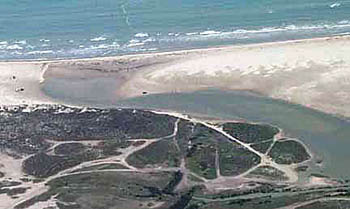|
| Home | | About Us | | Water Planning | |
Groundwater | |
Conservation | |
Environmental Flows | |
Drought Mgmt. | |
Resources | |
Search | | ||
|
Water for the Environment Updated October 7, 2010 In Texas, like much of the West, the concept of leaving water for the environment has long been controversial. Water left in a river to flow out into an estuary or the Gulf of Mexico was once commonly described as 'wasted.' Today we know better.What are environmental flows?
Environmental flows are the amount of water a river, estuary or other freshwater system needs to maintain water quality and support fish and wildlife. Why flows matter
Keeping our rivers, streams, estuaries and wetlands healthy is important for many species of wildlife-and for the state's economy. Texas has seven major coastal estuaries, or bays, formed where freshwater from rivers mixes with the saltier water of the Gulf of Mexico. This mixture of salt and fresh water is vital for many marine species-including fish, shrimp, oysters and crabs-and fuels a $2 billion coastal recreational and commercial fishing economy.
Healthy rivers, wetlands, and estuaries are also important for many of the 600+ species of birds found in the state. For example, the endangered whooping crane, which winters on San Antonio Bay, feeds largely on blue crabs. Blue crab populations are strongly correlated with the volume of water flowing into San Antonio Bay from the San Antonio and Guadalupe Rivers. Freshwater fish in Texas' rivers need sufficient amounts of clean water to survive. Many species of fish also need higher flows at certain times of year so they can move to their spawning grounds and reproduce. Many wetland habitats, such as bottomland hardwood forests, depend on periodic out-of-bank flows from rivers and streams. 
Rivers at risk
Texas is growing faster than any other state in the nation; the state's population may double by mid-century. Projections, such as the National Wildlife Federation's 2004 report Bays in Peril, indicate that many of the state's estuaries could end up deprived of adequate freshwater, particularly in drier years. In many of Texas' rivers, water rights have been given out for more water than would be available during droughts. Currently many of these water rights are not being fully used, but that could change as the state's population continues to grow. The impacts on our rivers could be severe. In 2001 the Rio Grande simply stopped flowing before it reached the Gulf of Mexico. The river was low from a combination of drought and human alternations, such as the three huge reservoirs on the main stem of the Rio Grande and numerous others on its tributaries. This is a sobering fate for the "great river" that once supported extensive riverboat traffic upstream to Roma.  Overuse of groundwater also has an impact on rivers and streams. A spring known as Jacob's Well in the Hill Country gives rise to Cypress Creek, which merges with the Blanco River and eventually flows into San Antonio Bay. Jacob's Well, which had never stopped flowing in recorded history, has now gone dry twice in the past decade due to increased groundwater use from population growth in the area. Similarly, Comanche Springs in Fort Stockton once gave rise to a 30-mile long stream. As a result of groundwater pumping for agriculture, the spring has ceased to flow entirely except for brief periods after heavy rains. Overuse of groundwater also has an impact on rivers and streams. A spring known as Jacob's Well in the Hill Country gives rise to Cypress Creek, which merges with the Blanco River and eventually flows into San Antonio Bay. Jacob's Well, which had never stopped flowing in recorded history, has now gone dry twice in the past decade due to increased groundwater use from population growth in the area. Similarly, Comanche Springs in Fort Stockton once gave rise to a 30-mile long stream. As a result of groundwater pumping for agriculture, the spring has ceased to flow entirely except for brief periods after heavy rains. If we manage our water resources wisely, we can have the water we need for cities, industry and agriculture while leaving water flowing in our rivers and into our coastal bays. The new Environmental Flows Allocation Process gives us the opportunity to protect our rivers and bays by determining how much water they need to stay healthy and by looking at all the options for making that water available. |
|
|||||||||||||||||||||||


 Environmental
Environmental